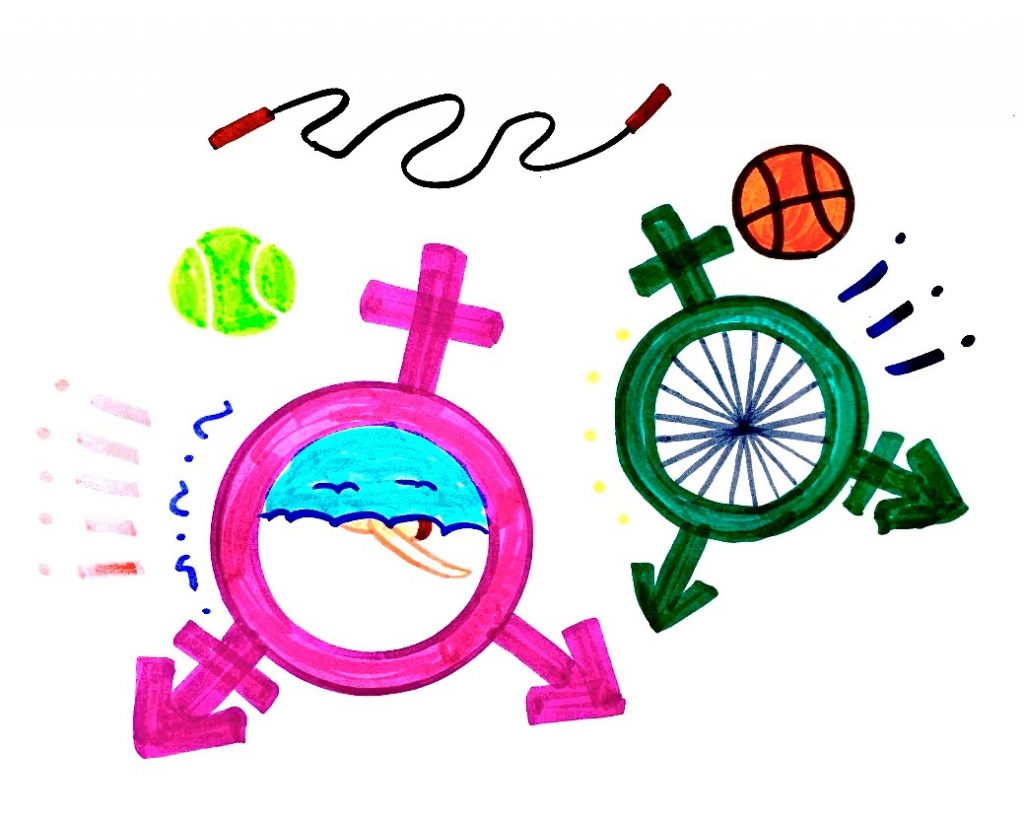You’re at the starting line, ready to run a 400 meter race: one lap on the Benjamin Franklin Middle School track. Around you are fellow athletes. The official blows the whistle to ready the athletes, he shouts, “on your marks!” and the gun goes off. You break into a sprint and fly down the track, and you’re in the lead! But swiftly passing you in lane one, another athlete shoots ahead of you at unprecedented speed. The gap between you both widens, and widens, until the athlete ahead finishes. You finish ten seconds later.
You’re astonished that you finished so far behind. How was that runner so insanely good? You feel like you should’ve won. In a way, it feels unfair.
This scenario is not uncommon for athletes competing against their transgender counterparts, especially in women’s sports. There’s a noticeable divide in biological capabilities between women who were biologically born male and those who were born female.
The debate over transgender acceptance in a binary sports culture began to grow with the decision of the International Olympic Committee (IOC) in 2016 to allow transgender athletes to compete in the Olympics. The topic has since resurfaced with the upcoming 2020 Summer Olympics in Tokyo. The games are expected to be the first in which transgender athletes participate.
The main focus of the argument involves transgender women competing against cisgender women because men are traditionally, biologically, more athletic than women due to genetics and hormones, and as a result possess advantages, including higher levels of testosterone and advanced height, both of which aid transgender women. The IOC is privy to these advantages, and has instituted a policy in which transgender athletes must take medication to reduce their testosterone levels, but to a threshold far higher than the regular levels women possess. Testosterone levels aren’t the only determining factor in an athlete’s aptitude though, and medical physicist and transgender athlete Joanna Harper says that hormone therapy does not completely dispel all advantages. Regardless, the IOC allows a hormonal advantage, albeit a reduced one.
Some disadvantages do arise for transgender athletes. Trans women reduce their muscle mass and aerobic capacity by diminishing their levels of testosterone, yet still keep their larger bodies. As a result, they are artificially weaker but naturally bigger, which isn’t the most ideal body composition for an athlete. Brazilian volleyballer Tifanny Abreu surprised everyone by boasting an even lower level of testosterone than females normally have. Yet that didn’t make much difference, as she went on to break countless women’s Brazilian volleyball records. Even with a perceived disadvantage, she excelled.
Ms. Abreu agrees that she may possess some advantages, but she says she is simply following the rules. She just wants to play, and she’ll follow the rules to do so. And a reevaluation of the rules is in order. Considering fairness for the majority of athletes, finding a solution to this issue is imperative instead of keeping the current regulations of the IOC.
Of all the suggestions that have been posed by the IOC, none involve exclusion from participation; inclusion is an immutable standard. Some suggest a third category, one in which only transgender athletes compete. Others opt for a quota of transgender athletes per team, yet critics hearken back to the days of limiting black athlete participation, and deem a quota unfair.
Transgender athlete legislation also trickles down to the high school level. If colleges are paying attention to transgender athletes who are better than the rest of the competition, that arguably takes away spots from other high school athletes who would have been up there if not for transgender athletes dominating in their sport. With the abundance of athletic opportunities at RHS, RHS students could potentially be seeing some conflict like this arise in the future.
The discussion will continue. With the upcoming Olympics, only more evidence will surface to inform the debate and get closer to an ultimate decision. The topic is raw at the moment; transgender athletes have emerged and been on display but not yet on the Olympic scale.
So pay attention in 2020. Follow these athletes and try to notice any advantages they may possess. How do they make you feel? How would you feel losing out to someone who boasts genetic and hormonal superiority? On an international level in 2020, and before the IOC, each transgender athlete may claim more than just medals. They’ll each claim the title of star or saboteur.
Luca Richman
Social Media and Digital Content Editor
Graphic: Nicole Kye


Transgender is an adjective that refers to “born with the sex and gender not matching each other”, not only trans women.
Furthermore, there always are transgender female athletes who started transitioning before reaching puberty or very early into it – they don’t have the “large bodies”.
Lastly, the author did not talk about transgender males in the article whatsoever, although the article title says “transgender athletes”, not “transgender female athletes”